阅读量:0
STM32+W5500+以太网应用开发+001_TCP 服务器和客户端
实验效果1-TCP服务器
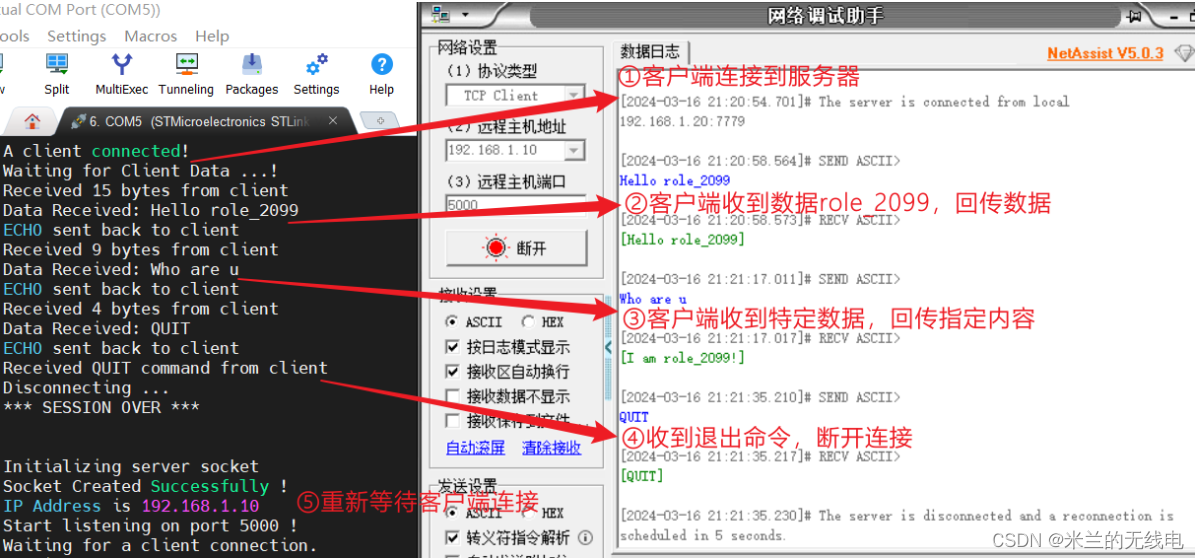
实验效果2-TCP客户端
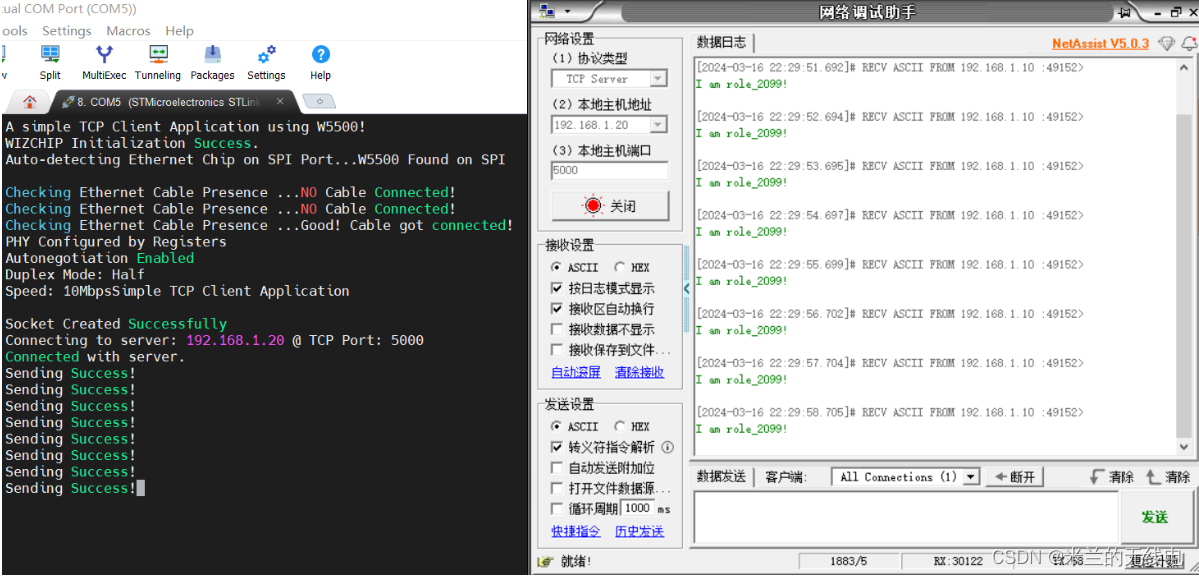
1 制作STM32CubeMX工程文件生成MDK工程
拷贝001_Ping.ioc到002_TCP文件夹,并重命名为002_TCP.ioc,重新生成MDK工程
2 添加W5500驱动库文件
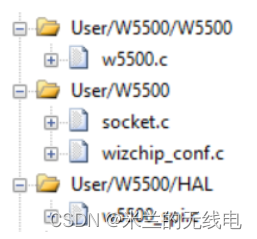
3 添加头文件目录

4 实例1-TCP服务器
4.1 修改main.c代码
只列举和上一个例子不同地方的代码,其他可以参照001_Ping例子
STM32+W5500+以太网应用开发+001_Ping 新建工程,移植驱动-CSDN博客
/* USER CODE BEGIN PTD */ #define LISTEN_PORT 5000 #define RECEIVE_BUFF_SIZE 128 wiz_NetInfo gWIZNETINFO = { .mac = { 0x80, 0x80, 0x80,0x80,0x80,0x80 },//MSB - LSB .ip = { 192, 168, 1, 10 }, .sn = { 255, 255, 255, 0 }, .gw = { 192, 168, 1, 1 },//网关参数 .dns = { 8, 8, 8, 8 }, .dhcp = NETINFO_STATIC }; uint8_t receive_buff[RECEIVE_BUFF_SIZE]; /* USER CODE END PTD */ /* USER CODE BEGIN 2 */ printf("A simple TCP Server Application using W5500!\r\n"); W5500Init(); //W5500初始化 ctlnetwork(CN_SET_NETINFO, (void*)&gWIZNETINFO); //配置网络参数 wiz_PhyConf phyconf; phyconf.by = PHY_CONFBY_SW; phyconf.duplex = PHY_DUPLEX_FULL; phyconf.speed = PHY_SPEED_10; phyconf.mode = PHY_MODE_AUTONEGO; ctlwizchip(CW_SET_PHYCONF, (void*)&phyconf); //配置PHY参数 PHYStatusCheck(); //检查网络连接状态 PrintPHYConf(); //打印PHY配置信息 printf("Simple TCP Server Application\r\n"); /* USER CODE END 2 */ while (1) { /* USER CODE END WHILE */ /* USER CODE BEGIN 3 */ printf("\r\nInitializing server socket\r\n"); //Parameters in order socket_id, protocol TCP or UDP, Port number, Flags=0 //Return value is socket ID on success if(socket(1,Sn_MR_TCP,LISTEN_PORT,0)!=1)//创建一个socket:Socket号,TCP/UDP类型,端口号 { //error printf("Cannot create Socket!\r\n"); while(1);//halt here } //success printf("Socket Created Successfully ! \r\n"); uint8_t socket_io_mode=SOCK_IO_BLOCK; ctlsocket(1, CS_SET_IOMODE , &socket_io_mode);//set blocking IO mode printf("IP Address is %d.%d.%d.%d\r\n",gWIZNETINFO.ip[0],gWIZNETINFO.ip[1],gWIZNETINFO.ip[2],gWIZNETINFO.ip[3]); printf("Start listening on port %d ! \r\n",LISTEN_PORT); printf("Waiting for a client connection. \r\n"); //Make it a passive socket (i.e. listen for connection) if(listen(1)!=SOCK_OK)//监听端口 {//our socket id is 1 (w5500 have 8 sockets from 0-7) //error printf("Cannot listen on port %d",LISTEN_PORT); while(1); } uint8_t sr=0x00;//socket status register do { sr=getSn_SR(1);//获取Sn_SR寄存器,参数0~7 }while (sr!=SOCK_ESTABLISHED && sr!=SOCK_CLOSED); if(sr==SOCK_CLOSED) { printf("Some error occurred on server socket. Please restart.\r\n"); while(1); } if(sr==SOCK_ESTABLISHED)//成功连接 { //we come here only when a client has connected. //Now we can read data from the socket printf("A client connected!\r\n"); printf("Waiting for Client Data ...!\r\n"); while(1) { int len=recv(1, receive_buff, RECEIVE_BUFF_SIZE);//从连接设备读取数据到receive_buff if(len==SOCKERR_SOCKSTATUS) { //client has disconnected printf("Client has disconnected\r\n"); printf("*** SESSION OVER ***\r\n\r\n"); break; } receive_buff[len]='\0'; printf("Received %d bytes from client\r\n",len); printf("Data Received: %s", receive_buff); if(strcmp((char*)receive_buff,"Who are u")==0) {//判断接收到"Who are u" memcpy(receive_buff,"I am role_2099!",15);//修改应答内容 len = 15; } //Echo the data back encloused in a [] pair send(1,(uint8_t*)"[",1);//starting sq bracket 向客户端发送[ send(1,receive_buff,len);// the data 向客户端发送接收到的内容或者特定的回答 send(1,(uint8_t*)"]",1);//closing sq bracket 向客户端发送] printf("\r\nECHO sent back to client\r\n"); //Look for quit message and quit if received if(strcmp((char*)receive_buff,"QUIT")==0) {//收到"QUIT",端口客户端连接 printf("Received QUIT command from client\r\n"); printf("Disconnecting ... \r\n"); printf("*** SESSION OVER ***\r\n\r\n"); disconnect(1);//disconnect from the clinet 断开客户端连接 break;//come out of while loop 退出,回到131行,重新等待客户端连接 } }//While loop (as long as client is connected) }//if block, client connect success } /* USER CODE END 3 */ 4.2 测试
1> ping测试,确认通信正常

2> 客户端未连接时log信息
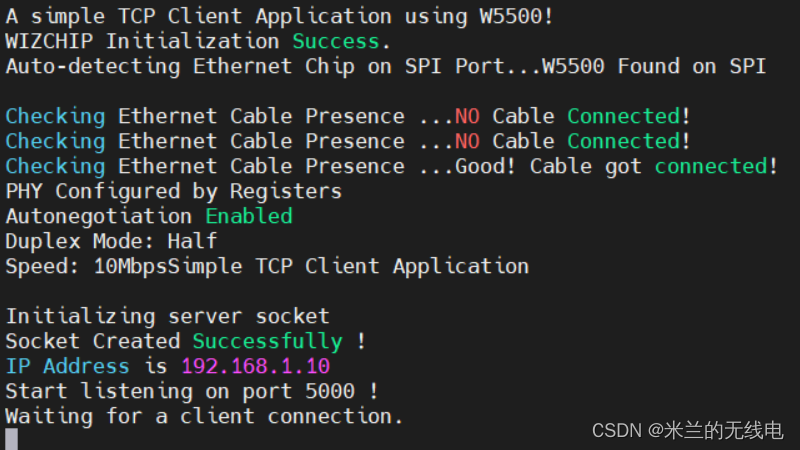
3> 使用网络调试助手配置为客户端,远程主机地址是开发板IP地址,端口号5000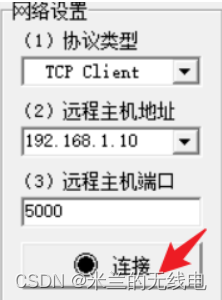
4> 连接成功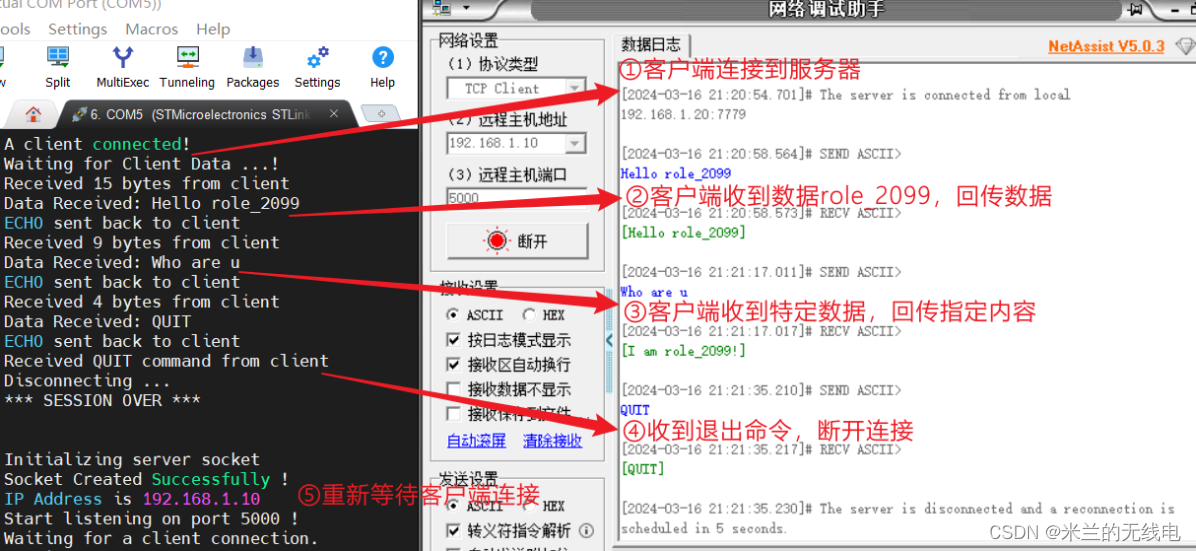
5 实例2-TCP客户端
5.1 修改main.c代码
/* USER CODE BEGIN PTD */ uint8_t destination_ip[]={192,168,1,20}; //远程主机地址 uint16_t destination_port = 5000; //远程主机端口 #define LISTEN_PORT 5000 //本地主机端口 #define RECEIVE_BUFF_SIZE 128 wiz_NetInfo gWIZNETINFO = { .mac = { 0x80, 0x80, 0x80,0x80,0x80,0x80 },//MSB - LSB .ip = { 192, 168, 1, 10 }, //IP地址 .sn = { 255, 255, 255, 0 }, //子网掩码 .gw = { 192, 168, 1, 1 }, //网关参数 .dns = { 8, 8, 8, 8 }, //DNS .dhcp = NETINFO_STATIC }; //DHCP关闭 uint8_t receive_buff[RECEIVE_BUFF_SIZE]; /* USER CODE END PTD */ /* USER CODE BEGIN 2 */ printf("A simple TCP Client Application using W5500!\r\n"); W5500Init(); //W5500初始化 ctlnetwork(CN_SET_NETINFO, (void*)&gWIZNETINFO); //配置网络参数 wiz_PhyConf phyconf; phyconf.by = PHY_CONFBY_SW; phyconf.duplex = PHY_DUPLEX_FULL; phyconf.speed = PHY_SPEED_10; phyconf.mode = PHY_MODE_AUTONEGO; ctlwizchip(CW_SET_PHYCONF, (void*)&phyconf); //配置PHY参数 PHYStatusCheck(); //检查网络连接状态 PrintPHYConf(); //打印PHY配置信息 printf("Simple TCP Client Application\r\n"); /* USER CODE END 2 */ while (1) { /* USER CODE END WHILE */ /* USER CODE BEGIN 3 */ //The return value of socket() call is the socket number if success //we are using socket number 1 so it should return 1 for success //The 3rd argument is the local port, when a client app is written //better give 0 here, that will use a random available port if(socket(1, Sn_MR_TCP, 0, 0)==1) //创建Socket=1 { printf("\r\nSocket Created Successfully"); } else { printf("\r\nCannot create socket"); while(1); } printf("\r\nConnecting to server: %d.%d.%d.%d @ TCP Port: %d",destination_ip[0],destination_ip[1],destination_ip[2],destination_ip[3],destination_port); if(connect(1, destination_ip, destination_port)==SOCK_OK) //连接远程主机 { printf("\r\nConnected with server."); } else { //failed printf("\r\nCannot connect with server!"); while(1); } while (1) { //Return value of the send() function is the amount of data sent if(send(1, "I am role_2099!\r\n", 16)<=SOCK_ERROR) //向服务器发送数据I am role_2099 { printf("\r\nSending Failed!"); while(1); } else { printf("\r\nSending Success!"); } HAL_Delay(1000); } } /* USER CODE END 3 */ 5.2 测试
1> 电脑端没有开启程序指定的服务器和端口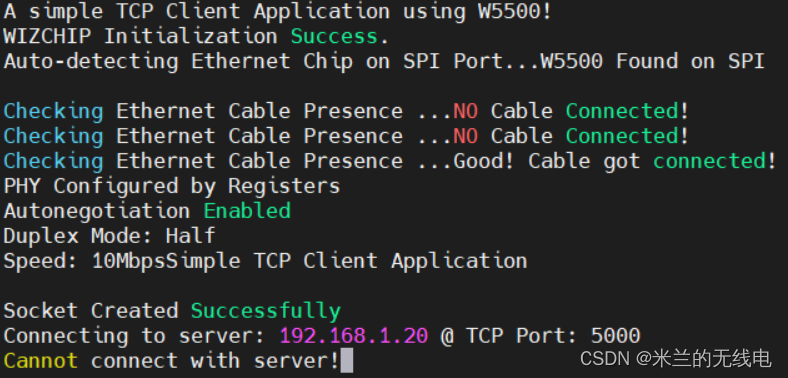
2> 网络调试助手配置,并开启服务器
3> 重新启动开发板,电脑端收到来自TCP客户端发来的信息
